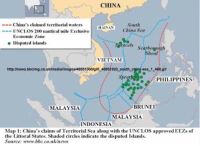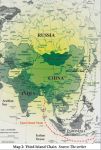Contemporary challenges in the IOEO in context of Policy are dominated by three currents. These are:
- The challenge of a rising China: Unfortunately, in its relationship with India it has shown no propensity to establish co-operative stabilising arrangements nor has it taken any measures to resolve long standing boundary disputes. Its collusion with reprobate states further pushes relationships downhill, the nuclear tie-up both in the weapon and civilian field with Pakistan along with possible doctrinal links; and in March 2010 failure to issue a condemnation when North Korea sank a South Korean warship does not suggest
- a pacific approach to relations. Its disputes with Japan and its forceful reassertion of claims to the Spratly and Paracel islands and to sovereignty over virtually the entire South China Sea are very serious ulcers in current relationships in the Eastern Oceans (see Map 1). This conundrum continues to push affected parties and like minded states into countervailing arrangements.
 |
| Click to enlarge |
Richard Behar, draws our attention to the “parasitic relationship” between China and the sub-Saharan nations.” These are strategic moves which are more than likely to cause friction between powers and demand an approach that embraces cooperation. Powers can coexist peacefully only when their rise is seen as one that does not hinder the other.
- The hyper power: Is the American posture in the South China Sea intrinsically antagonistic and would it break out into a hot conflict given the links that USA enjoys with Japan, South Korea, Taiwan and the other littorals of this region? The noises that currently emanate would seem to suggest that the war of words is just a few turns away from a conflictual situation.
- The mixed blessings of globalisation and the rise of nationalism: The impact of globalisation and the inability of the state to reconcile with the stresses that it places on the very concept of sovereignty, ought to be the focus. Nationalism which was the underlying force that sparked off the wars of the 20th century has today, become the source of China’s confidence. According to Yuan Peng of the China Institute of Contemporary International Relations “many Chinese scholars suggest that the govt. give up the illusion of US partnership and face squarely the profound and inevitable strategic competition”. It is also apparent that the surge of nationalism that sweeps China has led it to formulate an affordable military strategy of asymmetric weapons (the ‘assassin’s mace’ is part of such a strategy) This unorthodox strategy has set into motion three areas of rapid modernisation in the military establishment; firstly the most active land based ballistic and cruise missile programme in the world, secondly an enlarged nuclear attack and nuclear ballistic missile submarine fleet and lastly a concentration on what China calls “informatisation” an active and passive method of waging information warfare. China’s carousing with maverick nations such as Pakistan and North Korea does not in anyway enthuse confidence for the prospects of a stable future.
 |
| Click to enlarge |
Whatever force structures are developed should cater for the dominant three challenges. In the broadest of terms our vision would be ‘to create and deploy such forces which would establish and contribute to stability within these waters and should the need arise to deter hostile action, deny access to waters and littorals of interest or establish control over selected sea spaces’
Indo-US strategic framework
Of the three dominant currents discussed above, what direction China’s rise will take will be influenced by both internal as well as external factors. With the coming of the Third Island Chain (see Map 2); the maturing of the long range access denial strategy and the cultivation of the string of pearls, what is of relevance is that the potential for a collision is a reality and the only consideration that could deter it, is the ability of India to attain a strategic posture in the IOEO that serves to stabilise and should the need arise to deny or control. On the ‘globalisationn a t i o n a l i sm’ non-state actor c o n u n d r um, clearly plural societies with decentralised control are more likely to transform, adjust, adapt and tweak their systems, than monolithic centrally controlled states such as China which are intrinsically brittle; and as cracks begin to show, the fallout on the region can only be traumatic.
Since Independence, Indo-US relations have seen dizzy highs and plummeting lows. It began with the Roosevelt, Truman and Eisenhower administrations (1940s and 50s) pumping in massive funds to build infrastructure without giving too much thought to building a strategic relationship. By the 1971 war relations had touched rock-bottom and remained there through Pokhran 1, the break up of the Soviet Union and into the 1990s. The period was marked by a state of knee-jerk ‘drift and sanction’ and in the absence of a strategic locus, left the relationship rudderless.
It was after the 1998 nuclear tests that the two countries awoke to the realities that an engagement suggested. The consequence was the inking of the ‘Next Step in Strategic Partnership’ an agreement that identified and formalised areas of bilateral cooperation in January 2004 which included civil nuclear enterprises, civil space programmes, missile defence and high technology deals. Of critical importance was the opening of technology doors which culminated in the watershed Indo-US nuclear agreement of 18 July 2005. The larger significance of this deal was the arrival of India on the global stage as an equal and an acceptance of its potential to play an influencing role.
India today stands as a strong society that provides an oasis of stability amidst a clutch of disintegrating and failing states in a rough neighbourhood that hosts two inimical nuclear armed nations with close military and doctrinal links. Robust Indo-US relations provide the means to bringing about balance in the region. While it remains premature to translate these ties to deeper involvement, it is the maritime dimension, that opens up the maximum possibilities. India has shown itself; through restraint, pluralistic and popular form of governance to be a responsible state that upholds the status quo yet invites change through democratic forces. Its rise, in the main, is not only welcomed in Southeast Asia but is seen as a harmonising happening that could counterpoise China. Given the objective realities of the situation, the next step would logically be to establish an Indo-US strategic framework in the maritime domain.
The Indian nuclear doctrine
India’s strategic nuclear policy is articulated in her nuclear doctrine made public on 04 January 2003. The doctrine presents two perspectives; the first deals with ‘Form,’ nuclear war avoidance is the leit motif. It reinforces the belief that nuclear weapons are not for use, so ‘No First Use (NFU)’ is a natural choice. And yet the logic of self-preservation and of foreseeable power equations demanded that relations not be held to ransom on account of an inability to respond in a manner to deter convincingly. The existential nuclear challenges demanded credibility of the deterrent resting on the three pillars of surveillance, readiness and survivability. Given these settings the arsenal provides for alternatives and a guarantee that the second strike would cause unacceptable damage without any suggestion of a calibrated response.
A major infrastructural centre in the Andaman Sea must be accompanied by establishing base support facility arrangements in Indonesia, Vietnam and Japan in the Southern islands (Kyushu / Shikoku). To the west, the Indian Ocean littorals such as South Africa, Malagasy, Tanzania, Mauritius and Seychelles will have to be cultivated
The second part of the doctrine deals with ‘Substance’, with operationalising the deterrent and Command and Control as the main themes. Development and deployment of the ‘Triad’ are so structured that the three pillars of credibility are neither compromised nor readiness undermined. Command and Control is arranged in a manner that there exists clear division between Control and Custodian with multiple redundancy and dual-rule release authorisation at every level. Separation of Control from Custodian, effectively rules out conventionalising the deterrent. Command of the arsenal under all circumstances remains a political prerogative with comprehensive ‘hot stand-by’ provided in the Nuclear Command Authority.
To recapitulate, salients of the Indian Nuclear Doctrine are listed below:
- Nuclear weapons are political tools.
- The nuclear policy would be steered by a ‘Punishment Strategy’ its guiding principle would be No First Use.
- India would develop and operationalise a credible minimum deterrence with the necessary flexibility, mobility and mass.
- Retaliation to a first strike would be massive and would seek to cause unacceptable damage. Unacceptability of damage is directly linked to the credibility of deterrence. It would be of such magnitude that a‑would-be ‘first-striker’ is dissuaded from contemplating the strike.
- The use of Chemical, Biological or any other WMDs will invite the nuclear option.
- Nuclear weapons will not be used against non-weapon state.
- India declared a unilateral moratorium against nuclear testing. It also assured the world of continued stringent controls over proliferation.
- The goal of global nuclear disarmament remains.

 von
von